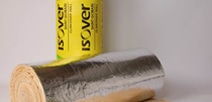As part of a trial into solid wall insulation by the Energy Saving Trust, Saint-Gobain Isover installed its newly launched Optima Internal Wall Insulation (IWI) system into a three bedroom family home in Bolton, Greater Manchester.
 Recent figures have revealed that the installation resulted in a reduction of the wall U-values by 84 per cent, contributing to 26 per cent less fuel being used to heat the house – a saving of £312 per year (a figure that will of course increase as fuel prices rise). As a solid wall property, this work would eligible for significant grant funding under the current Energy Company Obligation (ECO), as well as being a measure suitable for a Green Deal plan.
Recent figures have revealed that the installation resulted in a reduction of the wall U-values by 84 per cent, contributing to 26 per cent less fuel being used to heat the house – a saving of £312 per year (a figure that will of course increase as fuel prices rise). As a solid wall property, this work would eligible for significant grant funding under the current Energy Company Obligation (ECO), as well as being a measure suitable for a Green Deal plan.
At the end of 2011, the Energy Saving Trust (EST) commenced the largest in situ solid wall insulation trial ever undertaken inEngland. By gathering a detailed data set from more than 75 houses across the country, the EST aimed to develop a clearer understanding of building performance in relation to domestic solid wall insulation.
As part of this project, Isover’s Optima IWI system was installed at the Bolton property, in order to better understand the effectiveness of internal solid wall insulation in a variety of areas:
- Reducing energy bills through lower fuel consumption
- Decreasing CO2 emissions, as a result of minimised fuel consumption
- Controlling internal ambient temperatures
- Reducing energy waste through heat leakage
- The effectiveness of internal wall insulation, as a way to address the problem ofBritain’s un-insulated, solid wall housing stock – approximately 7.5 million homes
The house is a post-1900, three storey, mid-terrace house with solid, natural stone walls. The home has three bedrooms and two bathrooms, as well as a kitchen-diner, living room, study and a utility room. Double glazing is installed throughout and a single storey extension has recently been constructed at the rear of the house.
Because the home has ‘conservation status’, and was constructed of natural stone, external wall insulation (EWI) was not considered suitable for the property and, as such, IWI was decided on as the most appropriate and effective form of insulation by the owners and architects.
The Bolton house was fitted with Isover’s Optima IWI system, an insulation solution specifically designed to improve the thermal performance of solid or ‘hard to treat’ walls.
System components were assembled in-line with installation guidelines, insulating all walls within the property, with the exception of the extension (which had been built to more recent Building Regulations with an insulated cavity wall), and the two bathrooms. In addition, Isover’s Protect external wall treatment was applied to the external surface of the masonry wall to control moisture ingress.
To accurately assess the effectiveness of Optima IWI, a variety of data from the insulated property was collected and analysed. This included thermal imaging, measurement of the U-value and air permeability. Temperature and humidity sensors were also installed to monitor environmental conditions and smart meters were fitted to track gas consumption.


